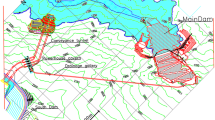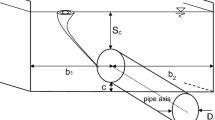Abstract
To reduce sediment accumulation in urban rivers due to the influence of cylindrical bridge piers on river flow resistance, the hydraulic performances of cylindrical piers were investigated using the computational fluid dynamics software FLOW 3D and compared with experimental data. The method included scouring and sedimentation analysis of piers and showed high accuracy at predicting experimental data. A dimpled surface pier was used as the model, and a series of simulations were conducted to evaluate its hydraulic performance. The results showed that scouring extents of a dimpled surface pier are larger than those of a cylindrical pier under different working conditions. This difference helped reducing sludge sedimentation at the bottom of the river in the former. The ratio of the maximum sedimentation height to the pier diameter (\({d}_{\mathrm{h}}/D\)), ratio of the sedimentation area, and cross-sectional area of the dimpled surface pier (\({A}_{\mathrm{h}}/{A}_{\mathrm{D}}\)) are all smaller than those of a cylindrical pier at different flow velocities, indicating that dimpled surface piers have a lower silting probability. Compared with cylindrical piers, dimpled surface piers offer less interference to turbulent flow and generate a small-scale spiral flow; a lower lateral velocity is also obtained behind the dimpled surface pier, which leads to lower flow resistances and lower energy dissipation, which helps scour.





















Similar content being viewed by others
Data availability
The data that support the findings of this study are available from the corresponding author, upon reasonable request.
References
Aksoy AO, Eski OY (2016) Experimental investigation of local scour around circular bridge piers under steady state flow conditions. J S Afr Inst Civ Eng 58:21–27. https://doi.org/10.17159/2309-8775/2016/v58n3a3
Al-Shukur AHK, Ali MH (2019) Optimum design for controlling the scouring on bridge piers. Civ Eng J-Tehran 5:1904–1916. https://doi.org/10.28991/cej-2019-03091381
Chiew YM (1992) Scour protection at bridge piers. J Hydraul Eng-Asce 118:1260–1269. https://doi.org/10.1061/(asce)0733-9429(1992)118:9(1260)
Chiew YM, Melville BW (1987) Local scour around bridge piers. J Hydraul Res 25:15–26. https://doi.org/10.1080/00221688709499285
Choufu L, Abbasi S, Pourshahbaz H, Taghvaei P, Tfwala S (2019) Investigation of flow, erosion, and sedimentation pattern around varied groynes under different hydraulic and geometric conditions: a numerical study. Water 11(2):235. https://doi.org/10.3390/w11020235
Das VK, Chaudhuri S, Barman K, Roy S, Debnath K (2022) Pier scours in fine-grained non-cohesive sediment and downstream siltation, an experimental approach. Phys Geogr 43:365–382. https://doi.org/10.1080/02723646.2020.1801372
Farooq R, Ghumman AR (2019) Impact assessment of pier shape and modifications on scouring around bridge pier. Water 11(9):1761. https://doi.org/10.3390/w11091761
Fengshan Z, Mengyi C, Xiaojing H, Yuzhi X (2021) Estimation on afflux of bridge on plain rivers related to blockage ratio and Froude number. IOP Conf Ser, Earth Environ. Sci. (UK) 760:012041 (9 pp.)-012041 (9 pp.). https://doi.org/10.1088/1755-1315/760/1/012041
Ghaderi A, Abbasi S (2019) CFD simulation of local scouring around airfoil-shaped bridge piers with and without collar. Sadhana-Academy Proceed Eng Sci 44(10):216. https://doi.org/10.1007/s12046-019-1196-8
He L (2021) Numerical evaluation of the effects of the Dongzhuang reservoir on channel deposition in the Lower Wei River in China. J Mt Sci 18:1550–1563. https://doi.org/10.1007/s11629-019-5899-4
He ZJ, Zhang JM, He Y, Mu SS (2015) Research of optimal experiment on bridge pier types for reducing backwater. Int Conf Energy Mater Manufact Eng (EMME) 25:4001. https://doi.org/10.1051/matecconf/20152504001
Jahangirzadeh A, Akib S (2015) Experimental study for determination of collar dimensions around bridge pier. Baltic J Road Bridge Eng 10:89–96. https://doi.org/10.3846/bjrbe.2015.11
Jahangirzadeh A, Basser H, Akib S, Karami H, Naji S, Shamshirband S (2014) Experimental and numerical investigation of the effect of different shapes of collars on the reduction of scour around a single bridge pier. Plos One 9(6):e98592. https://doi.org/10.1371/journal.pone.0098592
Jia XP, Li YS, Wang HB (2016) Bed sediment particle size characteristics and its sources implication in the desert reach of the Yellow River. Environ Earth Sci 75(11):950. https://doi.org/10.1007/s12665-016-5760-9
Jiongxin XU (2006) Influence of variations in suspended sediment concentration and grain size on sediment deposition of Yichang- Hankou reach of Yangtze River. Adv Water Sci 17:67–73
Kang S, Khosronejad A, Yang XL (2021) Turbulent flow characteristics around a non-submerged rectangular obstacle on the side of an open channel. Physics of Fluids 33(4):045106. https://doi.org/10.1063/5.0042914
Khosronejad A, Kang S, Sotiropoulos F (2012) Experimental and computational investigation of local scour around bridge piers. Adv Water Resour 37:73–85. https://doi.org/10.1016/j.advwatres.2011.09.013
Kumar V, Raju KGR, Vittal N (1999) Reduction of local scour around bridge piers using slots and collars. J Hydraul Eng-Asce 125:1302–1305. https://doi.org/10.1061/(asce)0733-9429(1999)125:12(1302)
Kusuma MSB, Farid M, Habibi SA, Yasin DM, Johan E (2020) The influence of the new LRT pier to the sedimentation pattern around Ampera Bridge in Musi River, South Sumatera, Indonesia. Int J Geomate 18:159–167. https://doi.org/10.21660/2020.69.13240
Link O, Pfleger F, Zanke U (2008) Characteristics of developing scour-holes at a sand-embedded cylinder. Int J Sedim Res 23:258–266. https://doi.org/10.1016/s1001-6279(08)60023-2
Mastbergen DR, Van den Berg JH (2003) Breaching in fine sands and the generation of sustained turbidity currents in submarine canyons. Sedimentology 50:625–637. https://doi.org/10.1046/j.1365-3091.2003.00554.x
Melville BW (1997) Pier and abutment scour: integrated approach. J Hydraul Eng-Asce 123:125–136. https://doi.org/10.1061/(asce)0733-9429(1997)123:2(125)
Melville BW, Sutherland AJ (1988) Design method for local scour at bridge piers. J Hydraul Eng-Asce 114:1210–1226. https://doi.org/10.1061/(asce)0733-9429(1988)114:10(1210)
Mobasher AM, Mahmoud AH (2019) Backwater rise due to bridge piers in curved channels under subcritical flow conditions. Aust J Basic Appl Sci 13(1):117127. https://doi.org/10.22587/ajbas.2019.13.1.15
Nian-hu D, Xin-jian Z, Yan LIU, Zhi-gang GU (2009) Experimental study on characteristics of sediment scouring and deposition in dike-narrowed river channel of Lower Yellow River. J Hydraul Eng 40:688–695
Niazkar M, Talebbeydokhti N, Afzali SH (2021) Bridge backwater estimation: a comparison between artificial intelligence models and explicit equations. Scientia Iranica 28:573–585. https://doi.org/10.24200/sci.2020.51432.2175
Obied NA, Khassaf SI (2019) Experimental study for protection of piers against local scour using slots. Int J Eng 32:217–222. https://doi.org/10.5829/ije.2019.32.02b.05
Omara H, Elsayed SM, Abdeelaal GM, Abd-Elhamid HF, Tawfik A (2019) Hydromorphological numerical model of the local scour process around bridge piers. Arab J Sci Eng 44:4183–4199. https://doi.org/10.1007/s13369-018-3359-z
Pan BT, Pang HL, Zhang D, Guan QY, Wang L, Li FQ, Guan WQ, Cai A, Sun XZ (2015) Sediment grain-size characteristics and its source implication in the Ningxia-Inner Mongolia sections on the upper reaches of the Yellow River. Geomorphology 246:255–262. https://doi.org/10.1016/j.geomorph.2015.06.028
Pan JJ, He ZG, Shih WR, Cheng NS (2020) Numerical modeling of scour and deposition around permeable cylindrical structures. Int J Sedim Res 35:278–286. https://doi.org/10.1016/j.ijsrc.2020.01.001
Qin CC, Shao XJ, Xiao Y (2019) Secondary flow effects on deposition of cohesive sediment in a meandering reach of Yangtze River. Water 11(7):1444. https://doi.org/10.3390/w11071444
Soulsby R (1997) Ch.9:bedload transport. In Dynamics of Marine Sand
Van Rijn LC (1984) Sediment transport, part I: bed load transport. J Hydraul Eng 110:1431–1456. https://doi.org/10.1061/(ASCE)0733-9429(1984)110:10(1431)
Varchanis S, Tsamopoulos J, Shen AQ, Haward SJ (2022) Reduced and increased flow resistance in shear-dominated flows of Oldroyd-B fluids. J Non-Newtonian Fluid Mech 300:104698. https://doi.org/10.1016/j.jnnfm.2021.104698
Wang L, Zhang F, Tang H (2016) Relationship between water-blocking ratio and backwater for bridge piers on plain rivers. J Hohai Univ Nat Sci 44:386–392
Wu T, Shen S, Li T, Qin J (2021) Influence of operation of Sanshenggong Reservoir on sediment transport in the downstream river. J Hohai Univ Nat Sci 49:401
Xu JX (2002) River sedimentation and channel adjustment of the lower Yellow River as influenced by low discharges and seasonal channel dry-ups. Geomorphology 43:151–164. https://doi.org/10.1016/s0169-555x(01)00131-3
Xu JX, Hu CH, Chen JG (2009) Effect of suspended sediment grain size on channel sedimentation in the lower Yellow River and some implications. Sci China Ser E-Technol Sci 52:2330–2339. https://doi.org/10.1007/s11431-008-0269-4
Zhang Y, Wang P (2017) Deposition pattern and morphological process at hyperconcentrated flow confluences in upper Yellow River. J Hydraulect Eng 36:39–48
Acknowledgements
I would like to show my deepest gratitude to the editors and reviewers.
Funding
This research was supported by the Major Project of Henan Province (Grant number 201300311100).
Author information
Authors and Affiliations
Contributions
Data curation: Jiangfei Wang and Wei Tang; funding acquisition: Haisong Li; investigation: Jiangfei Wang and Wei Tang; methodology: Yisheng Zhang; software: Qi Zhou and Wei Tang; visualization: Haisong Li; writing review and editing: Yisheng Zhang.
Corresponding author
Ethics declarations
Ethical approval
Not applicable
Consent to participate
Not applicable
Consent to publish
Not applicable
Conflict of interest
The authors declare no competing interests.
Additional information
Responsible Editor: Philippe Garrigues
Publisher's note
Springer Nature remains neutral with regard to jurisdictional claims in published maps and institutional affiliations.
Rights and permissions
Springer Nature or its licensor (e.g. a society or other partner) holds exclusive rights to this article under a publishing agreement with the author(s) or other rightsholder(s); author self-archiving of the accepted manuscript version of this article is solely governed by the terms of such publishing agreement and applicable law.
About this article
Cite this article
Zhang, Y., Wang, J., Zhou, Q. et al. Investigation of the reduction of sediment deposition and river flow resistance around dimpled surface piers. Environ Sci Pollut Res 30, 52784–52803 (2023). https://doi.org/10.1007/s11356-023-26034-0
Received:
Accepted:
Published:
Issue Date:
DOI: https://doi.org/10.1007/s11356-023-26034-0




